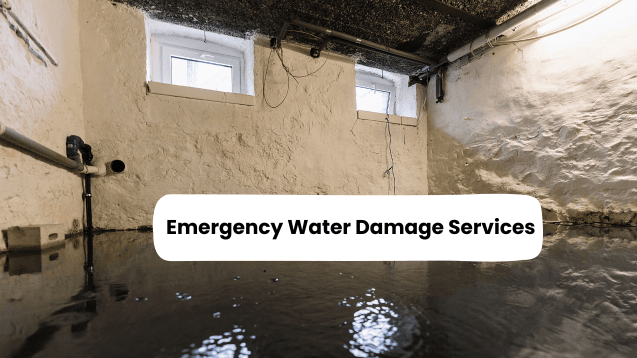One delay can turn a minor leak into a full-blown health hazard and financial nightmare. Emergency water damage services aren’t optional, they’re your only defense. Water damage can start small: a leaky pipe, a roof with a missing shingle, or a washing machine gone rogue. While the initial damage may seem minor, the consequences escalate quickly. Water that sits in your home penetrates walls, floors, and insulation, creating a damp environment perfect for mold spores to thrive.
According to the Environmental Protection Agency (EPA), mold can start growing within 24–48 hours of water exposure. Once established, mold can lead to structural damage, persistent odors, and serious health problems, including respiratory issues, allergies, and even immune system complications.
This underscores the urgency of professional intervention. Emergency water damage services act fast to halt the chain reaction that can lead from water intrusion to widespread mold infestation.
How Emergency Water Damage Services Protect Your Home
Emergency water damage professionals follow a systematic approach to prevent mold growth and restore your property. Their services include:
1. Rapid Water Extraction
The first and most critical step is removing standing water. Professionals use industrial-grade pumps and wet vacuums to extract water from carpets, floors, and other affected surfaces. This step is vital because the longer water remains, the higher the likelihood of mold formation. Quick extraction reduces moisture levels and limits the areas where mold spores can settle.
2. Industrial Drying and Dehumidification
After water extraction, the focus shifts to drying. Professionals use air movers, heaters, and industrial dehumidifiers to reduce moisture content in the air and pull water from hidden spaces, including wall cavities, under flooring, and inside insulation. Proper drying ensures that even areas not visible to the naked eye are safe from mold growth.
3. Cleaning and Sanitization
Water damage can carry contaminants, including bacteria and dirt. Cleaning and sanitizing affected areas are critical to prevent mold spores from taking hold. Emergency services apply antimicrobial treatments to surfaces to eliminate potential threats before mold can develop.
4. Mold Detection and Remediation
In cases where mold has already started to grow, professionals conduct thorough inspections and mold remediation. This involves identifying all affected areas, containing them to prevent cross-contamination, and safely removing mold. Specialized tools like HEPA vacuums and air scrubbers ensure that spores are eliminated effectively.
5. Preventive Measures and Monitoring
Once the initial damage is addressed, emergency water damage services often provide follow-up monitoring. This includes checking moisture levels, inspecting areas for hidden water damage, and advising on preventative steps to reduce future risk.
The Cost of Ignoring Water Damage
Many homeowners underestimate the risks of delayed action. Ignoring water damage not only increases the likelihood of mold growth but also leads to higher repair costs. According to the Insurance Information Institute, water damage and freezing are among the top reasons for property insurance claims, with average costs ranging from $10,000 to $15,000 for significant water events. Mold remediation alone can cost anywhere from $500 to $6,000, depending on severity.
Beyond financial costs, mold exposure can have long-term health consequences. Prolonged mold exposure can trigger allergic reactions, asthma attacks, sinus congestion, and chronic respiratory problems. For vulnerable populations, including children, the elderly, and those with compromised immune systems, these effects can be severe.
Tips for Homeowners to Minimize Mold Risk
While professional services are critical, homeowners can take steps to reduce risk:
- Immediate Action: Address leaks and standing water immediately. The faster water is removed, the less chance mold has to grow.
- Ventilation: Use fans and dehumidifiers to keep air circulating and reduce humidity levels.
- Routine Inspections: Regularly check basements, attics, and plumbing for signs of leaks or moisture accumulation.
- Maintain HVAC Systems: Mold can spread through ventilation. Keep systems clean and well-maintained.
- Proper Repairs: Replace damaged materials like drywall or insulation that have absorbed water to prevent hidden mold growth.
Why Choose Professional Emergency Water Damage Services
While DIY methods like mops and household fans may seem sufficient, they rarely address hidden moisture. Emergency water damage services combine speed, expertise, and specialized equipment to:
- Extract water efficiently from all affected areas
- Detect hidden moisture in walls, flooring, and ceilings
- Apply industrial drying techniques for comprehensive drying
- Use antimicrobial treatments to prevent mold growth
- Offer monitoring and advice to prevent future problems
Hiring professionals ensures that mold is prevented, property damage is minimized, and your home is restored safely.
Conclusion
Water damage is deceptively dangerous. A minor leak or burst pipe can quickly escalate into a mold problem that threatens both your home’s structure and your family’s health. Emergency water damage services act fast, providing water extraction, drying, cleaning, and mold prevention measures that homeowners simply cannot replicate with DIY solutions.
Time is the most critical factor, mold can begin forming within 24–48 hours. Acting immediately by contacting an emergency water damage service can save thousands in repairs and protect your home and health. Don’t wait for water damage to become a mold nightmare; the sooner the response, the safer and healthier your home will remain.
FAQs
- What should I do immediately after water damage?
First, stop the water source, turn off the main water supply or electricity if necessary. Then, remove standing water using mops or buckets. Dry the area with fans and dehumidifiers, and document the damage for insurance claims.
- How much does emergency water removal cost?
Emergency water removal costs vary based on the extent of damage and location. On average, homeowners spend between $1,200 and $5,000, with minor cases starting around $350.
- Will insurance cover water damage?
Homeowners insurance may cover water damage if it’s sudden and accidental, such as from a burst pipe. However, gradual leaks or flooding often require separate coverage. Always review your policy for specific exclusions.
